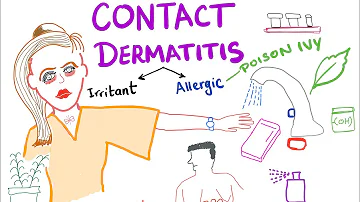What is sensitization dermatitis?
The skin allergy begins with a process called sensitization. It starts with the penetration of allergenic substances into the outer layer of the skin. The process lasts from four days to three weeks. During this period there are no signs of skin damage.
What is allergic dermatitis sensitization?
In humans, allergic contact dermatitis usually occurs in response to low molecular weight compounds after many repeated sub-threshold exposures that do not initially induce allergic signs and symptoms. This is termed the 'afferent' or 'sensitizing' phase of allergic contact dermatitis.

What is the difference between sensitization and allergy?
Sensitization is not the same as allergy. Sensitization does not always lead to symptoms, but symptoms do not develop without sensitization. In other words, you can be sensitized without being allergic, but you can't be allergic without being sensitized first.
What does Sensitisation mean in allergy?
Encountering an allergen once is therefore usually necessary to develop an allergy. The process through which a person's body becomes sensitive to a given allergen is known as sensitisation.
What is sensitization of skin?
Skin sensitisation is the regulatory endpoint aiming at the identification of chemicals able to elicit an allergic response in susceptible individuals. Following repeated exposure to a sensitising agent, the adverse health effect of allergic contact dermatitis (ACD) may be provoked.
What is the difference between irritation and sensitization?
Sensitization has symptoms similar to irritation (e.g., a red, itchy, bumpy rash). However, sensitization symptoms are caused by the body's immune reactivity to the product (or product components). In contrast, irritation symptoms are caused by the product. A sensitization reaction is a form of allergic reaction.
What causes allergic sensitization?
Allergen sensitization or atopy represents a predisposition of humans to generate IgE responses to biochemically heterogeneous molecules present in the environment. These molecules or allergens are derived from sources including arthropods, pollens, molds, and foods.
What is an example of sensitization?
One simple example of sensitization is that school children are frequently sensitized to the sound of a ringing bell when they are waiting for the end of the school day. You may experience cognitive sensitization when you are waiting for your cell phone to ring when you know someone important is about to call.
What are the 2 types of sensitization?
In summary, polysensitization can be divided into (i) cross-reactivity/cross-sensitization (the same IgE binds to several different allergens with common structural features) and (ii) co-sensitization (the simultaneous presence of different IgEs that bind to allergens that may not necessarily have common structural …
How is sensitization treated?
How Is Central Sensitization Treated?
- Aerobic Exercise. One of the simplest of exercise, this includes land-based exercise such as walking and stationary cycling. …
- Strength Training. …
- Flexibility Training. …
- Movement Therapies. …
- NSAIDs. …
- Acetaminophen. …
- Serotonin inhibitors. …
- Tricyclic Compounds.
What is sensitization treatment for allergy?
Allergen immunotherapy, also known as desensitization or hypo-sensitization, is a medical treatment for environmental allergies, such as insect bites, and asthma. Immunotherapy involves exposing people to larger and larger amounts of allergen in an attempt to change the immune system's response.
What happens after sensitization?
This process is called sensitization. It is not clear why some people become sensitized to certain allergens and some don't, but after sensitization each new encounter with the allergen induces an allergic reaction. Read more about the immunological mechanism of the allergic reaction.
Does sensitization go away?
Central sensitization can be difficult to diagnose, but fortunately, it's manageable and often reversible.
How do I stop sensitization?
Sensitization can be prevented by:
- Reducing the carbon content.
- Adding stabilizers such as niobium or titanium.
- Reducing the time of exposure to the critical temperature range.
What is the stage of sensitization?
Sensitization occurs in two phases: the first, the induction phase, is a result of initial contact with an allergen and primes the system; the second, the elicitation phase, is in response to a subsequent exposure and results in an allergic response.
How can I reduce sensitization?
Adding titanium and niobium to stainless steels and Inconel alloys can reduce the effects of sensitization. Because carbon prefers bonding with niobium and titanium over chromium, far less chromium is pulled out of the solution to form chromium carbide precipitates—keeping the oxide layer intact.
What causes sensitization?
Central sensitization involves specific changes to the nervous system. Changes in the dorsal horn of the spinal cord and in the brain occur, particularly at the cellular level, such as at receptor sites. As stated above, it has long been known that strokes and spinal cord injuries can cause central sensitization.
